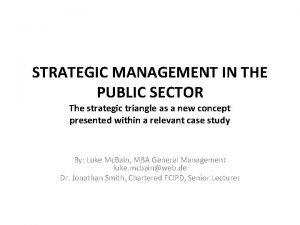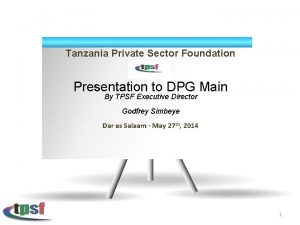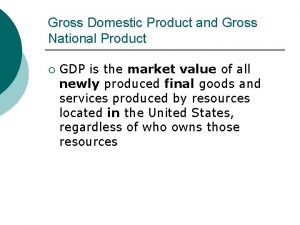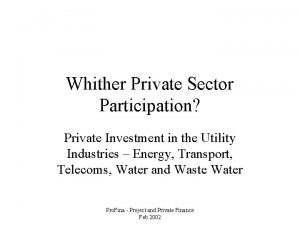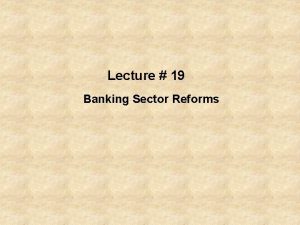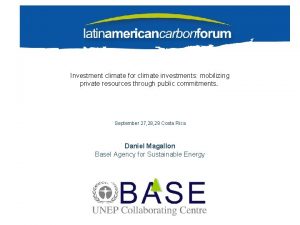Impact of investment climate reforms for private sector












- Slides: 12

Impact of investment climate reforms for private sector growth: what do we know? What should we learn? DIME Workshop, Business Environment Panel Marialisa Motta, Director, Financial and Private Sector Development, Latin America & Caribbean Region Co-Director, Investment Climate Practice; Financial and Private Sector Development Network Rio de Janeiro, Brazil. June 6, 2011

Outline • Financial and private sector development: objectives and pillars • Context and challenges in developing economies • Example of investment climate reforms and their impact • What do we need to learn? 2

Financial and private sector development: strategic objectives and pillars Create investments and jobs through a more efficient, competitive, and innovative private sector. Private sector development requires safe, deep and broad financial markets. Financial Systems Investment Climate Helps clients build policy framework and institutional capacity for effective prudential oversight, and prepare and respond to financial crises. Business regulation; trade & investment; private participation in infrastructure and social sectors. Innovation, Technology & Entrepreneurship Capital Markets Promotes generation and adoption of knowledge that contributes to firm creation, growth and higher value employment opportunities. Help clients develop capital markets and non -banking financial services, and improve corporate governance. Competitive Industries Financial Inclusion Provides targeted support to help strengthen the competitiveness of specific industries. Helps clients broaden and deepen financial markets to sustainably increase access for the underserved smaller firms and low income households. 3

Firms in developing economies have a harder time… Doing Business (DB) 2011 rankings on the ease of doing business Each vertical line shows the rank of one economy in the region DB Rank 183 DB Rank 1 OECD high income 30 Europe & Central Asia East Asia & Pacific Avg. GDP per capita (US$, 2009) $38, 580 $22, 181 72 87 Average DB Rank $6, 468 Middle East and North Africa 96 $5, 745 Latin America & Caribbean 96 $7, 220 117 South Asia $1, 040 137 Sub-Saharan Africa Source: “Doing Business 2011” Report, WDI Indicators 4 $1, 138

And lower access to finance than firms in high income countries MSMEs’ use of financial-institution loans or overdrafts 1 1 The number of MSMEs unserved or underserved is calculated based on MSMEs’ access to bank loans and overdrafts (i. e. , not including MSMEs’ access to trade financing, leasing, factoring, and other forms of credit. However, the value of the credit gap in dollars takes into consideration credit available through loans, overdrafts, leasing, factoring, trade finance and other forms of formal credit. Source: International Finance Corporation and Mc. Kinsey & Company (2010). 5

The impact of business start up reforms Liberia example Reduce time and cost of business start up by introducing standard articles of incorporation, eliminating the minimum capital requirement, introducing electronic registration. 5 procedures, 20 days, and US$ 88 12 procedures, 99 days, and US$ 630 30+ countries, including Belarus, Colombia, Tonga, Tajikistan. Reduction in time Increases new firms registered Reducing time to register a business by at least 40% • India: 6% increase in registered firms due to reduction of entry procedures 1 • Colombia: 5. 8% in newly registered firms due to One-Stop Shop 2 • Mexico: 5% new registered firms and 2. 8% jobs created due to a One-Stop Shop 3 • Entry reforms in Indian states with more flexible labor regulations led to increase in real output gains 18% larger than in states with less flexible labor regulations. Source: 1 Aghion et al. (2008), 2 Cárdenas and Rozo (2007), 3 Bruhn (2008). Graph source: Doing Business 2008, 2009, and 2010. 6

The impact of trade logistics reforms Reduction of number of documents for import and export; introduction of risk-based inspection and introduction of an electronic filing systems; and unification of custom operations at the borders. 10+ countries, including Rwanda, Colombia, Liberia. Increases Exports* in: • Sub-Saharan Africa by over 6% • Latin America by 3. 5% Reducing time to trade by 10% or more Improves Total Factor Productivity (TFP)**: Reducing customs clearance by 1 day in China generated a 7% increase in TFP for the consumer goods sector. Generates Private Sector Cost Savings: Trade logistics reforms would enable Colombian exporting firms to save US$ 20 million annually (from reduction in fees; projected). Source: Subramanian, Anderson and Lee (2011*, 2005**) 7

The impact of business exit reforms Improvement to the insolvency legal framework, introduction of out of court workouts and capacity building for insolvency administrators. 5+ countries. Example: Multicreditor agreement restructured US$ 4. 9 million in debt of Sportland International, an Estonian sporting goods company with operations in Latvia and Lithuania /1. 986 jobs were preserved. Debt recovery tribunals in India led to Increase in timely payments by 28%. Creditor friendly rules in Brazil resulted in Cost of debt reducing by 22%. A new reorganization Code in Colombia led to Repayment time reduced from 49 to 33 months. 1 Baltic News Service reported (January 28, 2010) that Sportland defaulted on its debt issue of EEK 57 million (US$ 4. 9 million). Visaria, 2009; Funchal, 2008; and Gine & Love, 2008. 2 Sources: 8

What do we need to learn? Entry: effects on entry of new firms in low income countries; effects on informality; do firms that enter because of a reduction in registration time and cost survive and grow? The Malawi and Minas Gerais cases will address some of these questions. Trade: effects on foreign direct investment and on corruption; effects of trade policies versus trade logistic reforms; effects of reducing number of documents versus introducing risk-based inspections or streamlining custom procedures. Exit: effect of legal reforms, versus introduction of out of court mechanisms or strengthening capacity of insolvency administrators; impact of communication of reforms to banks and firms. The Romania case will address some of these issues. Other investment climate topics: best policies to increase market competition; effects of reducing: number of licenses, time and cost of paying taxes or resolving a case in court; effects of introducing alternative dispute resolution mechanisms to resolve commercial disputes. The Senegal case will address some of these issues. For all topics: the relative effect of reforms on different industries (e. g. , perishable, construction, information and communication technologies) and on firms of different sizes; effects of combined reforms; sequencing of reforms; effect of investment climate reforms on corruption and transparency. 9

Background • Background information 10

Credit gap relative to current outstanding SME credit by region Formal SME outstanding credit $bn East Asia 2, 000 -2, 500 Central Asia and Eastern Europe 180 -230 60%-75% 125 -155 600 -700 16%-20% 105 -130 29%-35% 30 -40 Middle East and North Africa 80 -100 110 -140 11, 000 -13, 500 3, 000 -3, 700 125%-150% 600 -700 14, 000 -17, 000 Total excluding high-income OECD 300%-360% 80 -100 South Asia 95 -115 High-income OECD Gap as percentage of current outstanding SME credit $bn 11%-14% 250 -310 Sub-Saharan Africa 25 -30 Latin America Formal SME credit gap $bn 1, 300 -1, 600 700 -850 Source: International Finance Corporation and Mc. Kinsey & Company (2010) 11 5%-6% 8%-10% 21%-26%

Improving Transparency and Fostering Competition • Businesses need reliable information and a predictable regulatory environment, yet legal processes and regulations are often obscure. • Smaller, less connected businesses do not have access to lawyers and agents to navigate the labyrinth of regulations and procedures • Increased uncertainty, risk, rent-seeking Competition in Telecom Sector in Africa WBG played a key role in opening up these markets: • • New sector policy Regulatory framework Award of new licenses Privatization of incumbents The number of mobile cellular subscribers jumped from US$ 4 million to US$ 259 million between 1998 and 2008 Source: World Bank 2010 12
 Education sector reforms in pakistan
Education sector reforms in pakistan Climate change 2014 mitigation of climate change
Climate change 2014 mitigation of climate change Fixed investment and inventory investment
Fixed investment and inventory investment Impact of climate change on forest ppt
Impact of climate change on forest ppt How many major climate types are there worldwide brainpop
How many major climate types are there worldwide brainpop Ozeanklima
Ozeanklima Are sole traders in the private sector
Are sole traders in the private sector Strategic management in the public sector
Strategic management in the public sector Kuwaitization
Kuwaitization Tanzania private sector foundation
Tanzania private sector foundation Overseas private investment corp
Overseas private investment corp Demand-pull inflation occurs when
Demand-pull inflation occurs when What was the main cause of the punic wars?
What was the main cause of the punic wars?







